Ryan Hall's Blog, page 258
May 6, 2016
Speed Workouts You Can Do Anywhere
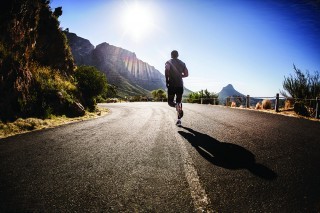
Photo: Istockphoto.com
Age-group runner Julie Thienel of Maryland doesn’t like the track, but she does like speed work. “I think the road much better mimics race conditions because you get hills and turns,” she says. “Plus, I feel I am less likely to get injured.”
If you’re like Thienel—or can’t get to the track—we’ve got you covered with four speedy workouts you can do anywhere.
The Workout: VO2 Max Ladder
Joanna Zeiger, a U.S. Olympian in triathlon, 2:43 marathoner and Race Ready Coaching founder, recommends this workout for any distance as a way to boost fitness and endorphins. “As we age, speed diminishes, so it’s important to incorporate some fast-paced sessions into your training, no matter your distance,” she says.
How to do it: The fast intervals should range between your 5K pace and 15 seconds per mile faster than 5K pace. After a 10- to 20-minute warm-up and 4 x 20-second strides, do two to four rounds of the following:
3 x (30 seconds fast/30 seconds easy)
2 x (45 seconds fast/45 seconds easy)
1 x (60 seconds fast/2 minutes easy)
Cool down with 10 to 20 minutes of easy jogging.
The Workout: 10K and Half Marathon Pacers
Zeiger says runners should try this one at least two weeks out from race day. “Use your goal race pace for the intervals,” she says. “This does not mean going faster on the shorter intervals and slowing on the longer intervals.”
How to do it: After a 10- to 20-minute warm-up and 4 x 20-second strides, run the following set two times:
2 minutes at race pace/1 minute easy
4 minutes at race pace/2 minutes easy
6 minutes at race pace/3 minutes easy
Half marathoners: Add in a second 6-minute interval after the second round
Cool down with 10 to 20 minutes of easy jogging.
The Workout: Road Loop Repeats
Steve Picucci, head cross-country and track coach at Morehead State University in Kentucky, designed this workout as an early-season strength session. “This workout is great for breaking up long tempos or transitioning from tempos and long runs to more intense workouts,” he explains.
How to do it: After a 10- to 20-minute warm-up and a few quick strides, find a loop that is relatively flat and 1–2 miles long. Run two to four repeats of each loop.
Run the first loop at a moderate intensity—around your half-marathon to marathon pace—and make sure you are not very winded after the first loop. Take a 1:30- to 2:30-minute active rest between each loop. Your goal is to cut down your time on each loop while keeping the rest period constant.
Cool down with 10 to 20 minutes of easy jogging.
The Workout: Speed Ladder
Picucci likes this one in season to help build speed while also focusing on some strength. “My athletes have done this one around a parking lot before,” he says.
How to do it: Warm up for 10 to 20 minutes with a few quick strides. Then find a flat area with minimal sharp turns. Don’t focus on a certain pace but rather aim to hit a desired effort level. Effort level on the way up should be at a four to five out of 10; on the way down, increase effort to a seven or eight.
Run hard for 30 seconds/jog easy for 60 seconds,
Run hard for 60 seconds/jog easy for 90 seconds
Run hard for 2 minutes/jog easy for 2:30
Run hard for 3 minutes/jog easy for 3:00
Run hard for 2 minutes/jog easy for 2:30
Run hard for 60 seconds/jog easy for 90 seconds
Run hard for 30 seconds/jog easy 60 seconds
Cool down with 10 to 20 minutes of easy jogging.
The post Speed Workouts You Can Do Anywhere appeared first on Competitor.com.
7 Pieces of Gear for On-The-Go
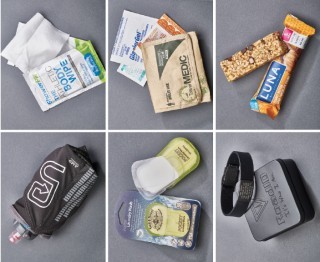
A simple joy of running is the fact that you can lace up and go without giving it much thought. But if a run or race takes you far from home, come prepared. While the actual running gear you bring depends upon personal preference and destination, the following essentials ensure comfort and safety wherever you choose to roam.
Photos: Mark Doolittle
Photo Gallery
1 of {count}
Back to Start
View Larger Image

Never be without water again by taking this soft, collapsible bottle with you. It’s equipped with a strap for hands-free carrying and has plenty of mesh pockets for gels and your hotel or rental car key.
View Larger Image

Showerpill Athletic Body Wipe, $10
Just say no to hotel soaps that leave clothes crusty and oddly scented. This slim packet contains 50 dissolvable sheets of soap (meaning no liquids to spill or get through security) so you can wash sweaty running togs in the sink.

Road ID Black Edition Elite, $40
This sleek band contains pertinent emergency info like your name, contact and health information. The all-black styling stands up to sweat yet still looks good with street clothes.
View Larger Image

Sea to Summit Pocket Laundry Wash, $4.50
Just say no to hotel soaps that leave clothes crusty and oddly scented. This slim packet contains 50 dissolvable sheets of soap (meaning no liquids to spill or get through security) so you can wash sweaty running togs in the sink.
View Larger Image

Adventure Medical Kits Travel Medic, $12
Leave your kids’ bandage strips and half-used tubes of ointment at home, and pack this handy all-in-one kit instead. Small enough to toss in a running pack or purse, the durable and reusable pouch has all the basics you need for simple first aid, and pain and allergy relief.
View Larger Image

Clif Peanut Butter Dark Chocolate Chunk Luna Bar, $18.75 (box of 12)
Toss a few of these yummy bars in your bag for quick, no-bonk energy. This 180-calorie snack has protein and healthy fats to keep you going until your next meal, and just 5 grams of sugar.
View Larger Image

Eagle Creek Cargo Hauler Duffle 60L, $99
Light and durable, this roomy carry-on has separate zip compartments for corralling wet and muddy gear, and a U-shaped opening on the main pocket for easy access. Wear it as a backpack—the straps are removable—or carry it comfortably at your side.

More Galleries
The post 7 Pieces of Gear for On-The-Go appeared first on Competitor.com.
T-Mobile CEO John Legere Buys Advertising Space on Nick Symmonds’ Arm
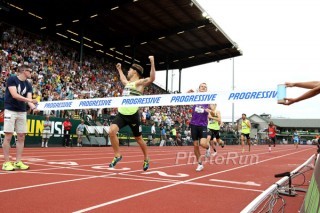
Nick Symmonds flashes his Run Gum tattoo in breaking the tape at last summer's U.S. Championships. Photo: PhotoRun.net
What does nearly $22,000 get you in track and field these days? Exactly nine square inches of advertising space on two-time Olympian Nick Symmonds right shoulder for the 2016 outdoor track season.
The eBay auction for the rights to advertise on the 32-year-old Symmonds’ skin ended yesterday. John Legere, the outspoken CEO of T-Mobile, posted the winning bid of $21,800. Symmonds made nearly twice what he did when he pulled the same stunt in 2012, when Hanson Dodge Creative, an advertising agency in Milwaukee, Wisc., posted a winning bid of $11,100.
“Happy to do my part to support USA running & this amazing athlete!” Legere Tweeted yesterday. “Now what should I put on @NickSymmonds’ arm??”
Symmonds has long been an advocate for athlete rights. He was left off last summer’s world championships team for refusing to sign a mandatory statement of conditions regarding which brand of apparel athletes are required to wear when representing Team USA at an international competition. Earlier this year, Symmonds’ company, RunGum, sued USA Track & Field, contending that non-shoe and apparel brands should be allowed to have their logos on athletes’ singlets at U.S. championship events. He will don the logo of RunGum, which makes caffienated chewing gum for athletes, and its URL on his left shoulder throughout the 2016 track season.
“The sale of my skin is just another example of an athlete taking control of the valuable space that we own,” Symmonds told ESPN’s Darren Rovell. “Allowing us to better market ourselves will inject tens of millions of dollars into the sport and help professional runners, 50 percent of which now live below the poverty line, make a living.”
The post T-Mobile CEO John Legere Buys Advertising Space on Nick Symmonds’ Arm appeared first on Competitor.com.
May 5, 2016
Photos: An Insider’s Glimpse at a Brooks Beasts’ Track Workout
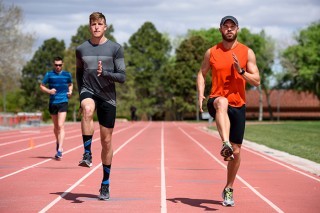
The Brooks Beasts Track Club recently held a training camp in the high-altitude environs of Albuquerque, N.M. The Seattle-based team of middle-distance runners is coached by Danny Mackey and gearing up for the 2016 U.S. Olympic Trials track meet, July 1-10 in Eugene, Ore. The top three in each event will earn a berth on the U.S. team that will be headed to Rio de Janeiro for the Summer Olympics in August. Here’s an inspiring day-in-the-life glimpse of a training camp track workout through the lens of photographer Craig Fritz.
Photo Gallery
1 of {count}
Back to Start
View Larger Image

Brooks Beasts' Training Camp
No track workout starts without a good warm-up run. Here's Drew Windle, Garrett Heath, Riley Masters, Matt Hillenbrand, Cas Loxsom and Dorian Ulrey getting loose before the workout begins. Photo: Brooks Running
View Larger Image

Brooks Beasts' Training Camp
After the warm-up, it's time for dynamic drills to loosen up the body. That's Cas Loxsom and Nick Symmonds, two of the best 800-meter runners in the U.S. Photo: Brooks Running
View Larger Image
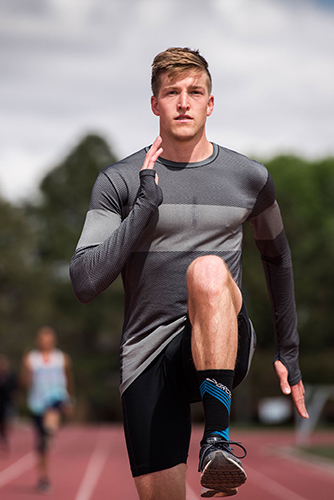
Brooks Beasts' Training Camp
The dynamic drills session includes a lot of high-knees drills. Loxsom was third in the 800 at the U.S. championships last year and earned a trip to the 2015 World Championships last year in Beijing. Photo: Brooks Running
View Larger Image

Brooks Beasts' Training Camp
And the butt-kick drill, as demonstrated by Hillebrand. He's a 3:57 miler and a former Southeastern Conference champion in the mile. Photo: Brooks Running
View Larger Image

Brooks Beasts' Training Camp
Before the workout actually starts, runners get their heart racing and their bodies primed with some fast-paced strides. Photo: Brooks Running
View Larger Image
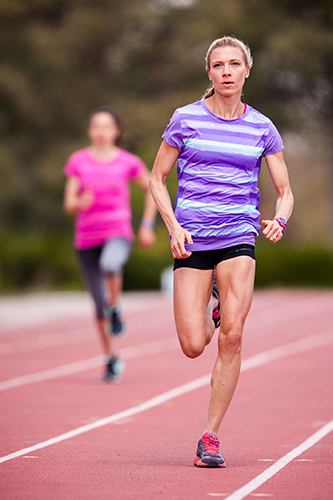
Brooks Beasts' Training Camp
Strides help replicate good running form, build strength and get a runner mentally ready to run fast in a workout. Here's Katie Mackey getting tuned up. Photo: Brooks Running
View Larger Image

Brooks Beasts' Training Camp
Coach Mackey lays out the goals of the day's workouts. The runners will specialize in events ranging from the 1,500 to the 5,000 at the Olympic Trials, so workouts and the emphasis within each workout are often slightly different. Photo: Brooks Running
View Larger Image

Brooks Beasts' Training Camp
This shot of Natalja Piliusina, Katie Mackey, Angela Bizzarri, Megan Malasarte, Jess Tonn, Gabriele Grunewald and Hannah Fields must have been taken before the workout. Trust us: at the end of the workout, most runners don't look so bright and cheery. Photo: Brooks Running
View Larger Image

Brooks Beasts' Training Camp
Here's what running looks like in the middle of an interval workout. That's Jess Tonn, Gabriele Grunewald, Katie Mackey and Angela Bizzarri heading down the homestretch. Photo: Brooks Running
View Larger Image

Brooks Beasts' Training Camp
Katie Mackey, Hannah Fields and Megan Malasarte get ready to roar. Photo: Brooks Running
View Larger Image

Brooks Beasts' Training Camp
In most interval workouts on the track, running consistently on each rep is key. Here Ulrey, Masters, Hillebrand and Heath get after it. Photo: Brooks Running
View Larger Image
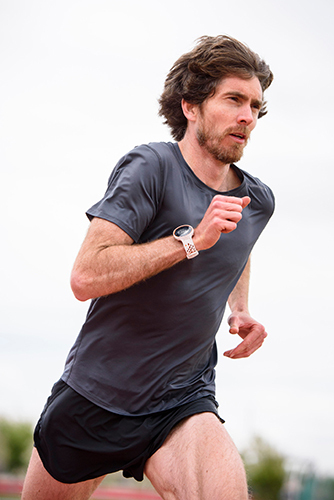
Brooks Beasts' Training Camp
Garrett Heath has earned a reputation as one of the world's best cross country runners. He was third at the Great Edinburgh Cross Country meet in January. On the track, he's a strong runner from 1,500m to 5,000m. Last year, he placed fourth at the U.S. championships in the 5,000. Photo: Brooks Running
View Larger Image

Brooks Beasts' Training Camp
They say you can't hide on the track, if only because it's the one place where speed and time are absolute. Here Jess Tonn, a seven time All-American while at Stanford, strides through another rep. Photo: Brooks Running
View Larger Image

Brooks Beasts' Training Camp
There's nothing quite like the feeling of a hard track interval session. It burns deep inside your lungs and deep inside your soul. Photo: Brooks Running
View Larger Image

Brooks Beasts' Training Camp
Nick Symmonds powers to the finish of a 400-meter rep. Symmonds is a two-time U.S. Olympian and the silver medalist in the 800m at the 2013 World Championships. Photo: Brooks Running
View Larger Image

Brooks Beasts' Training Camp
After the workout, Dorian Ulrey does some stretching while sipping on a recovery drink. Ulrey was an NCAA champion in the 3,000-meter run and also represented the U.S. in the 1,500 at the 2009 World Championships. Photo: Brooks Running
View Larger Image

Brooks Beasts' Training Camp
Megan Malasarte relishes in the successful completion of the workout. Sometimes it takes a moment it all to sink in. Photo: Brooks Running
View Larger Image

Brooks Beasts' Training Camp
Even Olympians like Nick Symmonds need direction—or some good-natured razzing— from a coach. Photo: Brooks Running
View Larger Image

Brooks Beasts' Training Camp
A good cool-down run is another key component, one that will help stave off lingering soreness the next day. Photo: Brooks Running
View Larger Image

Brooks Beasts' Training Camp
After the workout and stretching, there's always some good chatter and a few laughs among runners. Photo: Brooks Running
View Larger Image

Brooks Beasts' Training Camp
After the workout (and before the afternoon run), the Beasts (Heath, Mackey, Bizzarri and Malasarte) find ways to relax and hang out together. Photo: Brooks Running

More Galleries
The post Photos: An Insider’s Glimpse at a Brooks Beasts’ Track Workout appeared first on Competitor.com.
Why Power Might Be the Ultimate Training Metric for Runners

Since the 1950s, distance runners have trained by following structured programs and workouts backed by physiological testing and years and years of positive results.
Beginning in the late 1980s, heart-rate monitors added a new dimension to training, allowing for the advent of workouts based on specific heart-rate zones. Both methods have helped runners and triathletes of all levels improve their performance. By the early 2000s, GPS-enabled smartwatches made it easy to monitor pace, distance, elevation and other types of data.
As the modern age of wearable tech has started to unfold, a new measurement technology has the ability to revolutionize training for runners: the power meter.
Cyclists have used power meters since the 1990s to accurately measure how much power they’re outputting and how that effort corresponds with their physiology. Power is the primary metric for cyclists, although, granted, it’s a much simpler metric to understand on the bike—essentially a function of how much force is being exerted on the pedals, crank arms or rear hub to make it move.
Power meters for runners—and the corresponding training protocols based on power output—have only become available recently, so the art and science of using power for run training are still very much in their infancy. But those closest to the new technology—including pioneering coaches and elite athletes who are already incorporating power into their training—believe it can be a very important metric for running.
“What we need, clearly, is a better way to measure the stress we are inflicting in our daily training routines. And that’s exactly what the power meter provides, and it is why the power meter has the potential to revolutionize your run training,” says elite-level running and triathlon coach Jim Vance, author of “Run with Power: The Complete Guide to Power Meters for Running.”
“With a power meter, you can measure your performance and training stress more precisely than ever before. No longer will you wonder whether you are meeting the intensity, recovery, pace and volume goals of your training plan. Instead, you will erase any doubts about your training, and you will be able to monitor changes and improvements in every aspect of your running fitness.”
Up until recently, the only way running power has been measured has been via a laboratory setting using ground impact force plates. However, recent advances in 3D motion sensor technology has led to the development of running power meters with a multitude of accelerometers that can gauge forward, vertical and lateral force. In other words, how much energy it takes a person to move through space.
The use of power in run training will likely have a slow to gradual uptake among runners—and not until devices that track and support power (see below) become ubiquitous. There has already been (and will continue to be) pushback in favor of traditional training methods. But monitoring power—and understanding how to use it—could lead to true next-level advancements in run training, several experts have said.
“The importance of power is that it can give you some insights into the determinants of a runner’s performance beyond what a stopwatch can do—in particular, knowledge about your VO2 max, your lactate threshold and your efficiency or effectiveness of running,” says pioneering exercise physiologist Andrew Coggan, Ph.D., the co-author of “Training and Racing with a Power Meter.”
“This is really an exciting new time in that we haven’t had this data available previously outside of a laboratory setting,” Coggan adds. “So in many regards, the whole story that has evolved in cycling over the last two decades is now starting up again in respect to running.”
VIDEO: What is Power?
Why is power potentially so, well, powerful? First, power can allow a runner to precisely manage their training intensity—no matter if it’s on a hard workout such as an 8×400-meter interval session, a long progression run, a hill workout or a recovery run. In other words, it can tell precisely how hard a workout is as it relates to physiological markers like a runner’s lactate threshold. It’s one thing for a runner to run a 8×400 workout “hard” but it’s quite another to understand precisely how hard that actually is and how hard it should be. That kind of precision can help athletes train better, recover better and ultimately compress training cycles, Vance says, once coaches and athletes learn how to get more fitness from every workout.
Secondly, power—and only power—can help a runner monitor efficiency. That’s possible by showing how both immediate form tweaks during a run and long-term changes in running mechanics (based on form drills, increased strength, higher cadence or even better footwear) can allow a runner to run with less power output. If a runner can learn and train to run at the same pace using less power output for a given distance on a consistent basis—whether it’s a 5K or a marathon—it means that runner is becoming more efficient. The longer the race, the more important efficiency becomes.
Also, a runner can use power to optimize pacing and performance by using real-time power monitoring to understand the physiological demands of a workout or a race. Unlike heart rate or running pace (which have limitations and monitoring lag times), power is a near-instantaneous measure of the changes in a runner’s effort and also accounts for changes in terrain—for example, running uphill, downhill or over rolling terrain. Based on their own critical power number, runners can look at their power meters and understand precisely how hard of an effort to put out once a race begins.
“As advanced technology becomes available for runners, the opportunity to get a step on the competition increases dramatically for the early adopters. The runner’s power meter is the latest example of that,” says Joe Friel, founder of TrainingBible Coaching, co-founder of TrainingPeaks, and author of “The Triathlete’s Training Bible” and “The Power Meter Handbook.” “It’s a complex tool, but one with great potential for enhancing performance.”
Several running power meters are available on the market now or coming out very soon, including devices made by Stryd, RPM², SHFT and Lumo Bodytech. The purpose of this article is not to review the merits of each of those monitoring tools—all of which also record numerous other pieces of data—but instead to talk about the role of power as a key metric in running.
Several key training platforms have adopted power (including Training Peaks, Strava, 2Peak, Garmin Connect, Suunto Movescount and Golden Cheetah) and more smartwatch companies have begun making devices capable of displaying power output from a wireless connection to a power meter. (Polar, Garmin and Suunto are among those that already do in various ways.)
By itself, having a singular power output number on the face of a smartwatch face is no more relevant than having a singular heart rate statistic. It’s what that power number means relative to a runner’s individual fitness, workout or training plan.
When it comes to using power, there are three main things for a runner to understand:
1) An understanding of your individual power baseline; in other words, what is your capability or performance limitation, and your critical power or lactate threshold power number is what essentially measures that.
2) Once you have your baseline capability, you can create your own personal training zones, which are similar to segmented heart rate training zones, but, of course, based on power output. Vance has defined seven power zones in his book, ranging from walking/recovery (zone 1) to anaerobic/peak power (zone 7), and when, why and how to train in each zone.
RELATED: Seven Power Zones for Run Training
3) From there, workouts and training plans can be retrofitted to focus on power as the most critical metric.
“The problem for most runners is that they may be training in a gray area,” says Li Shang, Ph.D., Stryd co-founder and associate professor of engineering at the University of Colorado. “Athletes may not train themselves hard enough, but they also don’t get enough recovery. With power as the key metric, they know exactly how much power output they need.”
The ability to run more efficiently has always been a primary goal of runners. That’s what training and racing are all about. But the ability to make form changes—both in real time during a run or race and via longer term changes via drills and strength development—has always been an inexact science. That might be the most immediate way runners can benefit from power.
“Up until now, you could tell an athlete that they have to run taller or pick up their knees, but the athlete was only doing it because it sounded right. Now we have a device that can actually analyze it after you do it,” says Frank Jakobsen, a Danish triathlon and running coach with the Sansego training program. “Late in a race, an athlete can say, ‘I’m going to do this, I’m tough. I’m going to make it.’ But actually what they should be doing is creating a physiological response to make themselves more faster and more efficient.”
And what that can lead to, Jakobsen says, is the creation of mental picture—based on the understanding of efficient form gained from using a power meter—that will send synapses and nervous signals out to the muscles and create a certain movement.
“Saying ‘I’m tough’ is not going to create a movement. It’s going to move you forward, but it’s not going to create a certain movement in the muscles (that will make you more efficient). Whereas saying, ‘I’m going to run tall, I’m going to lead with my chest,’ that’s actually going to create a movement.’” With the advent of power monitors, a runner or triathlete can truly understand what physical movements need to be made to become more efficient late in a race by glancing at their wrist.
Combined with the idea of matching workouts to a specific race course—understanding precisely what kind of power output is needed at different parts of a course—power meters could help unlock another level of development for marathoner runners, trail runners, triathletes and everyone in between, Vance says.
But, just as with heart-rate monitors and GPS-enabled heart rate monitors, there will be early adopters, eager followers, skeptics and never-evers among the runner/triathlete population.
“New technology can be intimidating, and there will be some who will reject the very idea of using a power meter. They’ll say they are happy with the way they are doing things,” Vance says. “Once the best athletes come into contact with the best coaches, who know and understand how to use this technology and data to design training programs and improve an athlete’s weaknesses, the next revolution will begin.”
The post Why Power Might Be the Ultimate Training Metric for Runners appeared first on Competitor.com.
What Can You Do With Your Race Medals?
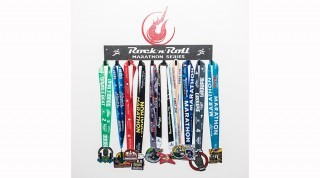
The race medal is a booming business.
According to a recent Wall Street Journal story, race medals are “competitive” currency in the world of road races. Whether you finish first or last, you can get a medal at many (if not most) road races around the country. Many runners pick races based on the bling.
RELATED: 6 Creative Race Medals You Can Use Every Day
But once the race is done and the medal is draped around your neck—what’s next?
A lot of runners have a plan on what they do with medals, but many don’t know. Here are some common ideas:
Photo Gallery
1 of {count}
Back to Start
View Larger Image
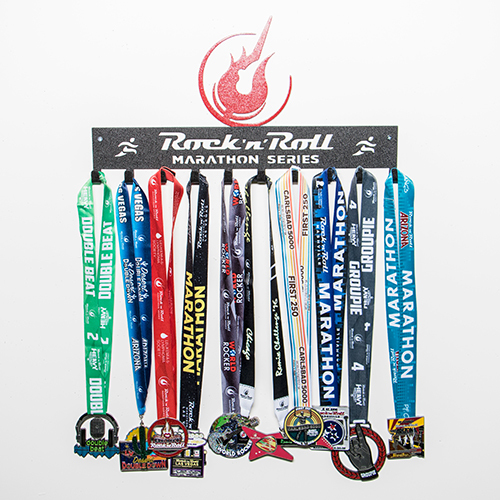
Display them!
For those who love medals and the hard work they represent, it only makes sense to find a way to show them off in your house. Many come up with a DIY project to display their medals. There are also businesses, like SportHooks that offer hangers designed specifically for race medals.
View Larger Image

Donate them!
In 2005, Medals4Mettle was founded in Indianapolis by Steve Isenberg, a surgeon and longtime runner who started giving his race medals to patients needing a morale boost. More than 10 years later, the all-volunteer charity has given more than 50,000 race medals to children and adults fighting debilitating illnesses. While runDisney medals are always a hit, the sheer variety and creativity behind race medals these days have proven popular with Medals4Mettle recipients.
The organization collects marathon, half-marathon and triathlon medals “that have been earned” (no surplus stashes from races are accepted). Volunteers put new ribbons on the donated medals and pass them out at hospitals around the world. For more information or to find out how to donate your medals or money, visit medals4mettle.org.
View Larger Image

Practical-ize them!
While some races offer race medals that double as a practical tool (think bottle openers), you can channel your inner arts-and-crafts talents to turn your medals into something more useful. Many runners take a hot glue gun and affix a magnet to the back of medals and throw them on the fridge. You can attach a hook to a medal to make a Christmas ornament. Or, if it’s a flat medal, you can glue cork to the back of it and make it a coaster for your coffee table.
View Larger Image

Find a child!
Want to make the day of a child? There are often many hanging around the finish line of races waiting for mom or dad to finish up. If medals aren’t your thing, giving one to a child is a small act that will give them a big thrill. Try it!

More Galleries
The post What Can You Do With Your Race Medals? appeared first on Competitor.com.
The Story Behind New Balance’s Original ‘N’ Logo
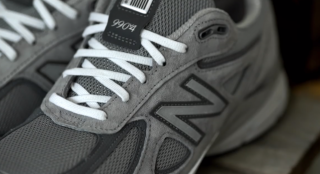
Ever wonder how a shoe brand came up with its logos? Here’s the story behind the New Balance “N” logo as told by its original designer Terry Heckler.
RELATED: How New Balance Makes Running Shoes in American Factories
The post The Story Behind New Balance’s Original ‘N’ Logo appeared first on Competitor.com.
May 4, 2016
Workout Of The Week: Threshold, Long, Threshold (TLT)
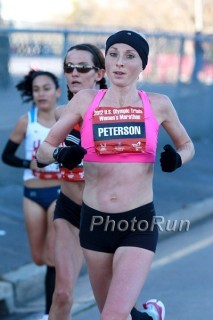
The TLT workout was a staple marathon session for Clara Peterson. Photo: www.photorun.net
The coach: Magdalena Lewy Boulet
The athlete: Clara Peterson, 16th at the 2012 U.S. Olympic Marathon Trials
When they did it: Peterson, who was a standout cross-country and track runner at Duke University, completed this workout as she was preparing for the California International Marathon in 2013. She ran this TLT workout six weeks before the race and ended up placing second in 2:35:50.
Why they did it: “I occasionally replace an easy long run with TLT to satisfy two workouts in one session [a long run and a threshold-paced run],” Lewy Boulet said. “This is a demanding session, but with great benefits. The inclusion of threshold running in the middle of 20-mile runs forces the running muscles to use up glycogen stores more rapidly than they would when running easy 20 miles.”
Lewy Boulet points out that you have the opportunity to practice fueling in this workout. Running at threshold pace after already completing 18 miles of running will make the marathon pace feel much more manageable on race day. Peterson also gained mental confidence by completing this session.
How they did it: Peterson started out with a 2-mile warmup. She then did 3 x 2 miles at threshold pace with 2 minutes of rest between each 2-mile repetition. She next ran 8 miles easy and then completed 2 miles at threshold pace. Peterson finished the workout with a 2-mile cooldown for a total of 20 miles. “Threshold ‘cruise intervals’ need to be run at proper intensity,” Lewy Boulet said. “They are meant to be comfortably hard, or about 83 percent of your VO2 max.”
How you can apply the workout: Admittedly, this is a hard workout. Lewy Boulet suggests instead of trying to keep track of miles, age group runners should focus on time. For example, marathoners should run 20 minutes easy for a warm-up and then run 3 x 15 minutes at your tempo pace (15 seconds faster per mile than your goal marathon pace) with 3 minutes rest between repeats. Then run 60 minutes easy and follow that with a final set of 15 minutes at tempo pace.
Conclude the workout with 20 minutes of easy running.
“This will provide you two hours and 40 minutes of quality running and prepare you well physically and mental for marathon race day,” Lewy Boulet said.
The post Workout Of The Week: Threshold, Long, Threshold (TLT) appeared first on Competitor.com.
New Professional Track & Field League to Debut in Eugene
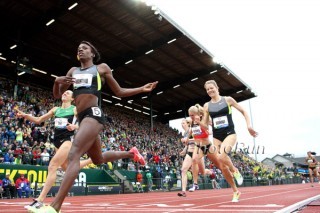
The University of Oregon's Hayward Field—shown here during the 2012 U.S. Olympic Trials—is known for having fervent fan support at big track meets like the NCAA Championships and the U.S. Olympic Trials. Photo: PhotoRun.net
For years, track and field athletes and administrators have kicked around the idea of having some sort of U.S. pro circuit of meets to showcase and foster American talent, but none have really taken off.
That dream becomes a reality this summer when the TrackTown Summer Series debuts on July 29 in Eugene., Ore. The meet will feature 144 athletes representing four teams from Portland, San Francisco, Philadelphia and New York City. Each squad will carry 36 athletes on its roster, split evenly between men and women, with competitors battling for prize money and additional benefits in excess of $500,000.
The meet, which will take place at the University of Oregon’s Hayward Field, will be broadcast live on ESPN or ESPN2.
The four teams will be chosen via a combination of a June 25 athlete draft and free agency. Athletes can register for the draft on June 1-15 online at gotracktownusa.com.
“I can’t wait to compete in the TrackTown Summer Series,” University of Oregon alum and elite middle-distance runner Laura Roesler said in a release. “Besides the obvious advantage of being able to compete in the U.S., the fact that ESPN has agreed to televise the series is truly amazing for the sport.”
The meet will also feature events open to recreational runners and walkers, including a 4-mile road race. Each person who signs up for the race will be assigned to a team and given a T-shirt to fly their team colors. The road race course includes a section on the famed Hayward Field track.
The TrackTown Summer Series is a new and innovative domestic circuit of scored track and field meets featuring competition between top teams of elite athletes in cities on both the East and West coasts. The series will expand in each of the next two seasons, possibly with regional meets leading up to a championship in Eugene.
“This is outstanding news for our sport,” TrackTown USA President and 2016 U.S. Olympic Men’s Head Track & Field Coach Vin Lananna said. “We look forward to continuing to explore fresh and creative ways to spark interest in track and field in the U.S.”
The idea for the TrackTown Summer Series first surfaced with a trio of High Performance meets at Hayward Field (2006, 2007, 2008) leading up to the 2008 U.S. Olympic Trials. It was followed by the highly successful Run TrackTown High Performance meet held in conjunction with the 2014 IAAF World Junior Championships.
“I’m really excited about this new series of meets,” added Oregon Track Club Elite’s Ben Blankenship. “Besides the obvious advantages of being able to compete in the U.S., the fact that ESPN has agreed to televise the series is truly amazing for the sport of track and field.”
The post New Professional Track & Field League to Debut in Eugene appeared first on Competitor.com.
Shoe Of The Week: New Balance Vazee Summit
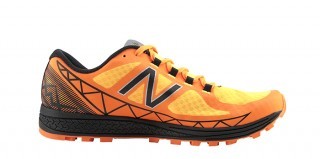
The Vazee Summit is a trail running shoe with a nice blend of cushioning and protection.
With the Vazee Summit, New Balance has developed a speed-oriented trail running shoe that will allow runners to zip over the trails with few inhibitions. Those who remember the sleek and low-to-the-ground 790s shoe from almost a decade ago will appreciate the Vazee Summit, which has plenty of giddy-up-and-go but also a bit more under the foot than some previous New Balance trail racers. The erstwhile 790 more or less morphed into the very minimal New Balance 100, which then turned into a not-quite-so nimble MT 101, which went away for a few years and then came back last year. The Vazee Summit shares some of the low-to-the-ground and minimal qualities of those previous shoes, but only to a point. It’s built off the same performance-oriented last as the Vazee Pace, which means its light, flexible and snug in the heel and midfoot and a tad wider in the forefoot.
What makes the Vazee Summit so special though is that it has just enough lightweight cushioning and purposeful protection to be a versatile shoe for most types of conditions for most types of runners. (Think of it as a smart midpoint between the minimalist 101 model and the more burly Leadville v3 shoes.) The three key features of the Vazee Summit are the breathable mesh upper that’s reinforced by a durable film overlay, a flexible rock plate that runs from the tip of the toes to under the arch and an outsole rubber and medium-sized lugs that are equally tacky on both wet and dry surfaces. The Vazee Summit is an ideal racing or fast-running trail shoe for distances from 5K to marathon. Its sweet spot is fast-cadence running on smooth to mildly technical terrain, although it can hold its own on extremely rugged terrain for short periods of time.
This is the shoe for you if … You’re looking for a fast, go-to trail shoe for most types of off-road running.
Price: $100
Weights: 9.3 oz. (men’s size 9.0); 7.5 oz. (women’s size 7.0)
Hell-Toe Offset: 10mm; 27mm (heel); 17mm (forefoot)
Info: NewBalance.com
RELATED: Shoe Of The Week—Montrail Caldorado
The post Shoe Of The Week: New Balance Vazee Summit appeared first on Competitor.com.
Ryan Hall's Blog
- Ryan Hall's profile
- 21 followers



